| Article ID | Journal | Published Year | Pages | File Type |
|---|---|---|---|---|
| 4158504 | Journal of Pediatric Surgery | 2009 | 8 Pages |
PurposeThe aim of the study was to compare the self-reported practice patterns of Canadian general surgeons (GSs) and pediatric general surgeons (PGSs) in treating blunt splenic injuries (BSIs) in children.MethodsForty-five PGSs and 690 GSs were surveyed (internet and hard copy). χ2 was used to compare groups; logistic regression was performed to determine independent factors influencing management variables.ResultsThirty-three PGSs and 191 GSs completed the survey, for a response rate of 30%. Pediatric general surgeons are more likely than GSs to follow American Pediatric Surgical Association guidelines (52% vs 11%; P < .0001). In diagnosing BSIs, PGSs and GSs are equally likely to use computed tomography (CT) over ultrasound for initial imaging. Pediatric general surgeons are less likely to consider CT injury grade in deciding on nonoperative management (NOM) (odds ratio [OR], 0.2; confidence interval [CI], 0.07-0.5; P = .002) and are more likely to continue NOM for patients with contrast blush on CT (OR, 6.5; CI, 2.5-17; P = .0002). Pediatric general surgeons report more selective intensive care unit use, hospital stay, follow-up imaging, and activity restrictions. No differences were found in the management of splenic artery pseudoaneurysms.ConclusionDifferences exist between PGSs and GSs in the management of pediatric BSIs, resulting in higher operative rates, use of resources, and radiation exposure. Further education of GSs in NOM and establishment of management guidelines are indicated.
